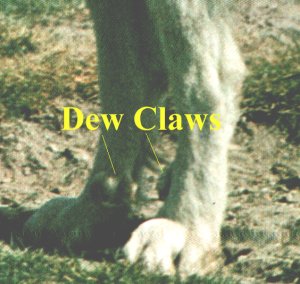 Back
Back
WHAT ARE DEW CLAWS AND SPLINT BONES ? First broadcast on www.provet.co.uk |
This information is provided by Provet for educational purposes only.
You should seek the advice of your veterinarian if your pet is ill as only he or she can correctly advise on the diagnosis and recommend the treatment that is most appropriate for your pet.
Horses have splint bones and some dogs have "dew claws" - but what are they ?
Surprisingly splint bones in horses and dew claws in dogs have a common origin - they are the remnants of anatomical structures originally present in their 5-toed ancestors !.
Many mammals (including humans) have evolved from ancestors which had 5 digits on their feet or hands - these were called "pentadactyles". In the original anatomical design of pentadactyles the lower limb consisted of a joint - called the carpus in the front leg, the tarsus in the hind leg. Below this joint were 5 long bones -called the metacarpals in the front leg, the metatarsals in the hind leg, and each of these ended with a joint to a digit. A digit (a finger or toe) would originally consist of up to 3 smaller bones - called phalanges. The end (3rd) phalanx would grow a nail or claw.
Even ancestors of the modern horse originally had 5 toes, but now horses and ponies have evolved to walk and run on one digit (the middle or 3rd toe) - the equivalent of a humans middle finger ! Below the carpus - confusingly now also called the "knee" joint in horses - and below the tarsus, there is a large bone which is the 3rd metacarpal or metatarsal bone, also called the cannon bones. These are some of the strongest bones in the skeleton - and to the sides and slightly behind these are two shorter, thin long bones which are the rudimentary remnants of the 2nd and 4th metacarpals or metatarsals - which are known as the "splint bones".
Modern day dogs have 4 toes on both the front and the hind legs. Higher up on the inside of the forelimb, adjacent to or below the carpal joint, it is common to find remnants of the the first digits - called "dew claws". Front dew claws are usually properly formed with joints and they are tucked in tight to the leg, and do not cause the animal many problems. However, because the nails on the dew claws do not get worn down naturally during exercise they should be trimmed regularly and occasionally they can get caught when the animal exercises, in which case the claw may break.

Hind leg "double" dew claws on a Pyrenean Mountain Dog
Higher up on the inside of the hind leg, below the tarsal joint, dew claws are less commonly found - but they are seen in quite a few large and giant breeds of dog. Unlike front dew claws hind dew claws are often not fully formed, and do not have proper joints so they hang loosely and are much more likely to get caught during exercise. Some breeds of dog even have double dew claws - 2 on each side.
Dew claws or splint bones do not usually cause any problems for the animal but sometimes they do . If dew claws keep getting caught they are removed surgically to stop the dog having repeated discomfort. In horses and ponies splint bones can become inflamed or even fractured and cause lameness - so treatment becomes necessary.
Updated October 2013